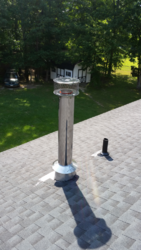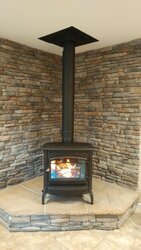First-time stove buyer
- Thread starter Chasm
- Start date
-
Active since 1995, Hearth.com is THE place on the internet for free information and advice about wood stoves, pellet stoves and other energy saving equipment.
We strive to provide opinions, articles, discussions and history related to Hearth Products and in a more general sense, energy issues.
We promote the EFFICIENT, RESPONSIBLE, CLEAN and SAFE use of all fuels, whether renewable or fossil.
You are using an out of date browser. It may not display this or other websites correctly.
You should upgrade or use an alternative browser.
You should upgrade or use an alternative browser.
Highbeam
Minister of Fire
It's far south. Would be warmer at night, but for the high altitude. We went from cool nights in Oaxaca then west down to the coast at Puerto Angel and the difference was very noticeable. We celebrated New Years there and wined and dined outdoors every night. Even at midnight it was comfortable to be in a short sleeve shirt.But 78 during the day! That really is quite a swing.
Last edited:
Blazingembers7749
Member
I think the rule your referencing is nfpa 211's 3,2,10 rule. Chimney must extend 3ft out of the roofline and 2ft higher than anything withing 10ft. Not saying there isnt a 3,10 rule this is just the first time ive heard that.
Blazingembers7749
Member
I havent read thru the entirety of the post but you might be happier with a pellet stove as u can turn it on and have good heat in a few minutes and turn it off and have zero heat within 15 minutes or so
Where would the pellets come from?I havent read thru the entirety of the post but you might be happier with a pellet stove as u can turn it on and have good heat in a few minutes and turn it off and have zero heat within 15 minutes or so
Blazingembers7749
Member
I would try sourcing them from somewhere in mexico if at all possible. if its too much of a pia to get pellets then obviously it would not be a good choice. Also needing a consistant source of power may rule out a pellet stove as well. Draft should not be an issue since it will be forced air via a combustion blower. Just seems to fit the heating needs if pellets and electricity are readily avaible.
Blazingembers7749
Member
I do agree in this case a 2.0 or smaller firebox should probably be used if using a wood stove to extract heat for say 8 or less hours a day so that the operating temps get high enough to burning cleanly. So much of the initial loads btus is going to be used to heat the system to proper operating temps on a cold stove/system.
Most houses there work with nature. Another option would be to improve the passive solar aspects of the house. This might simply mean adding some windows on the south and west sides that allow sun to warm up the floors. With a deep soffit or awning or deciduous tree to shade the sun during summer months, this can be an effective way to warm the house. Another common heating option in Mexican houses is a built-in masonry cooking stove. These used to be horrible, smoking up the interior of the home, but there have been modern improvements that make them more efficient and cleaner burning. A rocket stove would also work.
Blazingembers7749
Member
Im not sure adding windows is going to help relieve night time temp drops. Any radiant heat from the added windows would quickly dissappear once the sun went down. Glad they are coming up with healthier alternatives for cooking cause breathing in all that smoke is horrible.
Yes, some heat will be lost, but this is not 20º weather outside. Last Nov. we stayed in Columbia at an even higher altitude in a home with no heat other than a fireplace. There was plenty of glass and night time temps in the mid 40's. It was cooler in the morning, but not miserable. With large patio doors the sun did a good job of warming the house. We only had a chill chaser fire one night. The thermal mass of the home made the difference.Im not sure adding windows is going to help relieve night time temp drops. Any radiant heat from the added windows would quickly dissappear once the sun went down. Glad they are coming up with healthier alternatives for cooking cause breathing in all that smoke is horrible.
Another option would be heating with propane if the goal is quick on and off and thermostatic control.
Last edited:
Blazingembers7749
Member
Still disagree with the window theory for the particular situation unless used in conjunction with a heat source other than solar radiant. Propane on the other hand would be ideal assuming a tank gasline and fuel are not an issue.
It gets hot on the coast. In the valley, inland high plateau, it's cool in the shade, never hot at night, but it can really scorch under the sunIt's far south. Would be warmer at night, but for the high altitude. We went from cool nights in Oaxaca then west down to the coast at Puerto Angel and the difference was very noticeable. We celebrated New Years there and wined and dined outdoors every night. Even at midnight it was comfortable to be in a short sleeve shirt.
Too much heat lost at night through windows. All solar gain lost rather quickly. If I were building a house I'd use solar and pump hot water under slab. But for what I got, I'm thinking a stove will do me rightStill disagree with the window theory for the particular situation unless used in conjunction with a heat source other than solar radiant. Propane on the other hand would be ideal assuming a tank gasline and fuel are not an issue.
Blazingembers7749
Member
Thank you folks. I have a better picture of size and pricing. Mr begreen: Is T19 comparable to T20? If so, I may be close to a purchase.
Next I'll have to bother you folk some more for info on what type stove pipe to buy and how to install piping/assembly.
Next I'll have to bother you folk some more for info on what type stove pipe to buy and how to install piping/assembly.
Blazingembers7749
Member
If the budget allows ive had good luck with ventis but theres plenty of other good options out there. 6" Appliance connector, Double wall connector pipe if budget allows Flat ceiling or cathedral? Flat go with 11" ceiling support box catherdral go with 24" ceiling support box. i would save money and not get truss spanners and frame around the box with 2*4s. You can get trim for the support box if you choose. The ceiling support boxes should come with an adaptor to go from connector pipe to class a chimney pipe. Class a pipe 304 should be sufficient. You want to go from the ceiling support box till the chimney ends with the class a pipe. Ceiling support box should extend into the room with the connector pipe at least 6". If in a attic recomend using attic insulation sheild. Ive only delt with metal and shingled roofs cut your hole run the pipe thru maintaining clearances put your roof flashing on storm collar and rain cap i like to use roof braces as well especislly if the chimney comes out of the roof more than 5 ft or in particularly windy areas. This is the basic version will need more information or pictures to give an actual pipe and parts breakdown as well as step by step instructions.
Blazingembers7749
Member
If the budget allows ive had good luck with ventis but theres plenty of other good options out there. 6" Appliance connector, Double wall connector pipe if budget allows Flat ceiling or cathedral? Flat go with 11" ceiling support box catherdral go with 24" ceiling support box. i would save money and not get truss spanners and frame around the box with 2*4s. You can get trim for the support box if you choose. The ceiling support boxes should come with an adaptor to go from connector pipe to class a chimney pipe. Class a pipe 304 should be sufficient. You want to go from the ceiling support box till the chimney ends with the class a pipe. Ceiling support box should extend into the room with the connector pipe at least 6". If in a attic recomend using attic insulation sheild. Ive only delt with metal and shingled roofs cut your hole run the pipe thru maintaining clearances put your roof flashing on storm collar and rain cap i like to use roof braces as well especislly if the chimney comes out of the roof more than 5 ft or in particularly windy areas. This is the basic version will need more information or pictures to give an actual pipe and parts breakdown as well as step by step instructions.
Thanks! These are new terms for me. I am presently in NY but will get some photos this week. What are pricing parameters for whole setup - high and low?? Class A pipe 6" or 8"? I saw some SS pipe sold on Craigslist, this one a triple wall: "12' long can be broken down into 4 sections with cap on top. 6" dia".............
This would be a very basic example.
https://newhaven.craigslist.org/for/d/stainless-stove-pipe-wood/6606130573.html
12' piece triple wall... is buying used a bad idea?
Looks like my attempt at sending photos failed. Will try again later
https://newhaven.craigslist.org/for/d/stainless-stove-pipe-wood/6606130573.html
12' piece triple wall... is buying used a bad idea?
https://jerseyshore.craigslist.org/for/d/wood-stove-out-pipe/6617244974.htmlLooks like my attempt at sending photos failed. Will try again later
The T19 is the predecessor and a fine value stove.Thank you folks. I have a better picture of size and pricing. Mr begreen: Is T19 comparable to T20? If so, I may be close to a purchase.
Next I'll have to bother you folk some more for info on what type stove pipe to buy and how to install piping/assembly.
To assess the best option for stove pipe and chimney it would help to see some pictures of the proposed stove location and if possible a shot of the ceiling and roof.
Similar threads
- Replies
- 15
- Views
- 2K
- Replies
- 11
- Views
- 673
- Replies
- 13
- Views
- 4K
- Replies
- 7
- Views
- 2K



